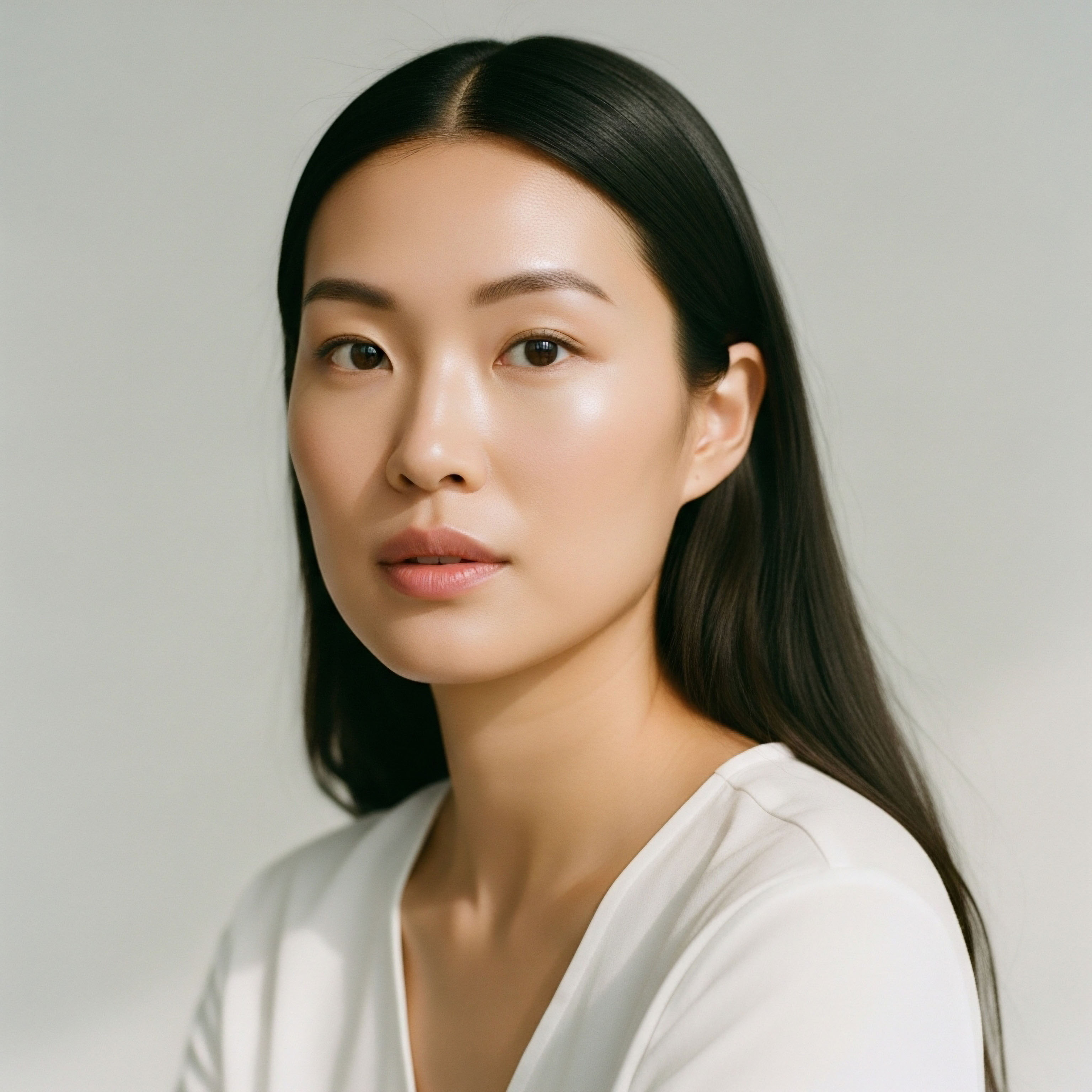

Fundamentals
You have noticed changes in your skin. Perhaps it is the unwelcome arrival of adult acne along the jawline, a gradual thinning of hair where it was once thick, or the appearance of coarse, dark hairs in unexpected places. These experiences are not isolated incidents; they are physical manifestations of a complex internal dialogue within your body.
This dialogue is conducted through a sophisticated messaging system, and one of its principal languages is that of androgens. Your journey to understanding these skin changes begins with appreciating the profound connection between these powerful hormones and the cells of your skin. The story is not written by the hormones alone, but by how your body chooses to listen to them.
At the heart of this interaction is the androgen receptor (AR), a specialized protein structure found within your cells. Think of it as a highly specific docking station or a lock. Androgens, such as testosterone and its more potent derivative, dihydrotestosterone (DHT), are the keys.
When an androgen key fits into an AR lock, it turns, initiating a cascade of genetic instructions within the cell. This process dictates cellular behavior, telling a sebaceous gland to produce more oil or a hair follicle to alter its growth cycle. The presence of androgens is a fundamental part of human physiology for all genders, influencing everything from bone density and muscle mass to mood and libido. In the skin, their effects are particularly visible.

The Cellular Conversation Androgen Receptors and Skin Structures
Your skin is a dynamic organ, populated by structures that are exquisitely sensitive to androgenic signals. The two most relevant to this discussion are the pilosebaceous unit, which consists of a hair follicle and its associated sebaceous (oil) gland, and the dermal papilla cells at the base of the hair follicle.
Sebaceous glands are a primary target. When androgens bind to the receptors in these glands, the command given is one of growth and increased production of sebum, the natural oil that lubricates the skin. A certain amount of sebum is essential for a healthy skin barrier.
An overabundance, however, creates an environment where pores can become clogged and acne-causing bacteria can proliferate. This explains why periods of hormonal fluctuation, such as puberty or perimenopause, are often accompanied by acne flares. The issue may not be an abnormally high level of circulating androgens, but a heightened sensitivity of the receptors within the sebaceous glands themselves.
Hair follicles respond to androgen signals in a paradoxical manner depending on their location. The same hormone, DHT, that stimulates the growth of coarse, dark hair on the face, chest, and limbs (terminal hair) can simultaneously cause the miniaturization of hair follicles on the scalp in genetically predisposed individuals.
This process, known as androgenetic alopecia, leads to finer, shorter hairs and, eventually, hair loss. The dermal papilla cells in these scalp follicles contain androgen receptors that, when activated, send signals that shorten the growth phase of the hair cycle.
The visible changes on your skin are the external result of an internal conversation between hormones and their cellular receptors.

Why Blood Tests Can Be Deceiving
A common point of frustration is receiving “normal” blood test results while still experiencing symptoms like cystic acne or progressive hair thinning. This is where the concept of receptor sensitivity becomes paramount. A standard blood panel measures the concentration of hormones circulating in your bloodstream. It does not, and cannot, measure what is happening at the cellular level ∞ how efficiently your androgen receptors are binding to these hormones and translating their messages.
You can have perfectly normal levels of testosterone and DHT, but if your receptors are exceptionally efficient or numerous in your skin cells, the biological effect will be amplified. It is as if the volume on the hormonal message is turned up high, even though the signal strength (the hormone level) is standard.
This explains why some individuals are highly susceptible to androgen-related skin issues while others, with identical hormone levels, are not. This variability in sensitivity is largely determined by genetics and local cellular factors, a topic we will explore in greater depth.
Understanding this distinction is the first step toward a more empowered perspective on your health. It shifts the focus from a simple question of “Are my hormones high?” to a more insightful one ∞ “How is my body interpreting my hormonal signals?” This reframing validates your lived experience; the symptoms are real, and they have a clear biological basis that extends beyond a simple blood measurement.


Intermediate
Moving beyond the foundational concepts of hormones and receptors, we can now examine the specific clinical manifestations that arise from variable androgen receptor sensitivity. Conditions like acne vulgaris, hirsutism, and androgenetic alopecia are not merely cosmetic concerns; they are diagnostic windows into an individual’s unique endocrine physiology.
The expression of these conditions is often dictated less by the absolute quantity of circulating androgens and more by the intricate dynamics at the target tissue ∞ the skin. This is the clinical reality where a person’s genetic inheritance and local cellular environment dictate the outcome of hormonal signaling.

The Clinical Spectrum of Androgen Receptor Sensitivity
The way androgen receptor sensitivity presents can vary dramatically from person to person. This spectrum of conditions highlights the tissue-specific and genetically programmed nature of the androgen response system. A key enzyme in this process is 5-alpha-reductase, which converts testosterone into the much more potent DHT locally within the skin. The activity of this enzyme, combined with the intrinsic sensitivity of the androgen receptor, creates a unique “androgenic footprint” in each individual.
- Acne Vulgaris ∞ In individuals with acne, the sebaceous glands can be considered hyper-responsive to androgenic stimulation. Even normal androgen levels can trigger excessive sebum production and inflammation when the receptors in the sebaceous glands are highly sensitive. This is further compounded by the local conversion of weaker androgens into DHT within the skin itself, a process that amplifies the hormonal signal directly at the source of the problem.
- Hirsutism ∞ This condition involves the growth of coarse, dark, male-pattern hair in women ∞ typically on the face, chest, and abdomen. It is a classic sign of androgen excess or, more commonly, heightened sensitivity of the hair follicles in these areas to normal androgen levels. The follicles are stimulated to transform from producing fine, light vellus hair to thick, pigmented terminal hair.
- Androgenetic Alopecia ∞ This form of hair loss demonstrates the paradoxical nature of androgen action. In genetically susceptible individuals, high AR sensitivity in scalp hair follicles leads to their progressive miniaturization. The binding of DHT to these receptors triggers a signaling cascade that shortens the anagen (growth) phase of the hair cycle, resulting in progressively finer and shorter hairs until the follicle ceases to produce visible hair.

What Determines Androgen Receptor Sensitivity?
The sensitivity of an androgen receptor is not a fixed trait but is influenced by several factors, primarily genetic. The gene that codes for the androgen receptor is located on the X chromosome and contains a highly variable region known as the CAG repeat sequence. This segment consists of repeating sets of three DNA bases (Cytosine-Adenine-Guanine). The number of these repeats can vary significantly among individuals.
Research has established an inverse correlation ∞ the fewer the number of CAG repeats, the more efficient and “sensitive” the resulting androgen receptor is at initiating gene transcription upon binding with an androgen. An individual with a shorter CAG repeat length will have receptors that are more easily activated, leading to a stronger biological response from the same amount of hormone.
This genetic variation is a primary reason why some people experience significant androgenic symptoms (like severe acne or rapid hair loss) while others do not, even within the same family.
Your genetic blueprint, specifically the structure of your androgen receptor gene, plays a decisive role in how your skin responds to hormonal signals.
This genetic predisposition provides a molecular explanation for the clinical observation that androgen-related skin conditions often run in families. It also explains why individuals of certain ethnicities may have a higher prevalence of conditions like androgenetic alopecia. The sensitivity is inherited, written into the very code of the receptor itself.

Hormonal Therapies and Their Cutaneous Impact
Understanding AR sensitivity is critical when considering hormonal optimization protocols, such as Testosterone Replacement Therapy (TRT) for men or the use of testosterone in women for symptoms related to menopause. These therapies directly introduce androgens into the system, and the skin’s response is entirely dependent on its pre-existing receptor sensitivity.
For a man undergoing TRT for hypogonadism, the introduction of testosterone can unmask a latent genetic predisposition for androgenetic alopecia or trigger acne, even if these were not issues previously. The therapy does not create the sensitivity; it provides the ligand (the “key”) that activates the already sensitive receptors.
This is why protocols for men often include ancillary medications like Anastrozole, an aromatase inhibitor that blocks the conversion of testosterone to estrogen, thereby managing one potential pathway of hormonal side effects. However, it does not directly address the conversion to DHT or the sensitivity of the AR itself.
Similarly, for a woman using a low-dose testosterone protocol to address symptoms like low libido or fatigue, the potential for androgenic skin manifestations is a primary consideration. While the doses are physiological for a female, an individual with high AR sensitivity may experience side effects like acne or unwanted hair growth. Monitoring these clinical signs is just as important as monitoring blood levels.
The table below outlines how different hormonal states or therapies can interact with varying levels of AR sensitivity to produce specific skin outcomes.
| Hormonal State / Therapy | Low AR Sensitivity | High AR Sensitivity |
|---|---|---|
| Normal Endogenous Androgens |
Minimal to no androgenic skin symptoms. Skin and hair are balanced. |
May experience idiopathic acne, hirsutism, or early-onset androgenetic alopecia despite “normal” hormone labs. |
| Testosterone Replacement Therapy (Men) |
Improved muscle mass and well-being with minimal skin side effects. May see some increase in skin oiliness. |
Increased risk of significant acne flares, accelerated scalp hair loss (androgenetic alopecia), and increased body hair growth. |
| Low-Dose Testosterone (Women) |
Therapeutic benefits (e.g. improved libido, energy) with little to no noticeable skin changes. |
Higher likelihood of developing acne (especially along the jawline), oily skin, or new facial/body hair growth even at low doses. |
| Polycystic Ovary Syndrome (PCOS) with Hyperandrogenism |
May show some signs like mild acne or hirsutism due to elevated androgens. |
Often presents with severe and persistent symptoms ∞ cystic acne, significant hirsutism, and female pattern hair loss due to the combination of high androgens and high sensitivity. |


Academic
An academic exploration of androgen receptor (AR) sensitivity and its cutaneous effects requires a shift in perspective from systemic endocrinology to the microenvironment of the skin itself. The skin is not a passive recipient of circulating hormones. It is a sophisticated, self-contained metabolic organ with the full enzymatic machinery to synthesize and modify potent androgens locally.
This concept, known as intracrinology, is fundamental to understanding why plasma androgen levels so often fail to correlate with the severity of clinical symptoms like acne and androgenetic alopecia. The true locus of control resides in the interplay between local androgen synthesis, the genetic polymorphism of the AR, and the recruitment of transcriptional cofactors within the dermal and epidermal cells.

The Molecular Architecture of Androgen Receptor Sensitivity
The functionality of the androgen receptor is determined at a molecular level by the structure of the AR gene, located at Xq11-12. The most studied feature influencing its activity is the polymorphic trinucleotide repeat sequence (CAG)n in exon 1, which encodes a polyglutamine tract in the N-terminal domain (NTD) of the receptor protein.
The length of this polyglutamine tract is inversely proportional to the transactivational capacity of the receptor. A shorter tract, resulting from fewer CAG repeats, creates a receptor protein that is conformationally more active and efficient at initiating gene transcription upon ligand binding.
This structural efficiency has profound clinical implications. Studies have demonstrated that men and women with androgenetic alopecia, hirsutism, and severe acne tend to have, on average, shorter CAG repeat lengths compared to control populations. This genetic feature acts as a biological amplifier.
For instance, in a dermal papilla cell of the scalp, a highly efficient AR (short CAG repeat) will respond more robustly to even minute concentrations of DHT, accelerating the process of follicular miniaturization. This provides a clear molecular basis for genetic predisposition to baldness that is independent of systemic androgen levels.

How Does Intracrinology Dictate Local Androgen Action?
The skin, particularly the sebaceous gland and hair follicle, is an active steroidogenic factory. It expresses a suite of enzymes capable of converting weak adrenal precursors, like dehydroepiandrosterone (DHEA) and androstenedione, into testosterone and, crucially, into DHT. This local production means that the concentration of potent androgens at the site of action can be many times higher than what is measured in the bloodstream.
The key enzymatic steps in this cutaneous pathway are:
- Steroid sulfatase ∞ Converts DHEA-S (the abundant circulating precursor) into DHEA.
- 3β-hydroxysteroid dehydrogenase (3β-HSD) ∞ Converts DHEA into androstenedione.
- 17β-hydroxysteroid dehydrogenase (17β-HSD) ∞ Converts androstenedione into testosterone. This is a critical step, and different isoforms of this enzyme are expressed in different skin structures.
- 5α-reductase (Types 1 and 2) ∞ Converts testosterone into DHT, the most potent natural androgen, which binds to the AR with significantly higher affinity and a slower dissociation rate than testosterone.
This intracrine system explains why a post-menopausal woman, whose ovarian testosterone production has ceased, can still experience androgenic symptoms. Her adrenal glands continue to produce DHEA, which is then converted into powerful androgens directly within her skin cells. The activity levels of these enzymes, which can also be genetically variable, combined with the innate sensitivity of her AR, determine her clinical presentation.
The skin functions as an independent endocrine organ, creating its own potent hormones that interact with genetically programmed receptors.

The Role of Cofactors in Modulating the Androgen Receptor Signal
The binding of an androgen to the AR is only the first step. For the receptor to effectively regulate gene expression, it must recruit a host of other proteins known as coactivators and corepressors. These molecules are the final arbiters of the transcriptional signal. Coactivators, such as those from the p160 family (e.g. SRC-1), bind to the activated receptor and help link it to the general transcription machinery, enhancing its effect. Corepressors have the opposite function.
The specific milieu of cofactors available within a cell can fine-tune the androgenic response. It is hypothesized that variations in the expression levels of these cofactors in different tissues and individuals may further explain the diversity of androgenic effects.
For example, a sebocyte might express a unique combination of coactivators that preferentially enhances the AR’s ability to transcribe genes involved in lipogenesis, leading to increased sebum production. This adds another layer of regulatory complexity, suggesting that AR sensitivity is a product of not only the receptor’s structure but also its protein-protein interactions within the nucleus.
The table below summarizes the key molecular determinants of androgenic response in the skin, moving from the systemic to the intracellular level.
| Regulatory Level | Key Components | Impact on Skin Manifestations |
|---|---|---|
| Systemic (Endocrine) |
Circulating levels of Testosterone, DHEA-S, Androstenedione. |
Provides the precursor hormones. Poorly correlates with symptom severity due to local metabolism. |
| Local (Intracrine) |
Activity of 5α-reductase, 17β-HSD, and other steroidogenic enzymes in skin cells. |
Determines the local concentration of potent androgens like DHT at the target site (sebaceous gland, hair follicle). |
| Receptor (Genetic) |
Androgen Receptor (AR) gene polymorphism, specifically the CAG repeat length. |
Dictates the intrinsic efficiency and “sensitivity” of the receptor. Shorter repeats lead to a more potent transcriptional response. |
| Post-Receptor (Transcriptional) |
Expression and availability of nuclear coactivators and corepressors. |
Fine-tunes the final output of the AR signal, modulating the intensity of the genetic instructions sent to the cell. |
This multi-layered regulatory system underscores the inadequacy of a simplistic model based solely on blood hormone levels. A comprehensive understanding requires an appreciation for the skin’s metabolic autonomy and the genetic and proteomic factors that govern the cellular response to androgens. Therapeutic interventions, whether they involve systemic hormonal administration or topical agents, are ultimately interacting with this complex, localized biological system.

References
- Sawaya, M. E. & Shalita, A. R. (1998). Androgen receptor polymorphisms (CAG repeat lengths) in androgenetic alopecia, hirsutism, and acne. Journal of cutaneous medicine and surgery, 3(1), 9 ∞ 15.
- Lai, J. J. Chang, P. & Lai, K. P. (2013). The Role of Androgen and Androgen Receptor in the Skin-Related Disorders. IntechOpen.
- Zouboulis, C. C. (2000). Androgens, progestins, and antiandrogens. In Fitzpatrick’s Dermatology in General Medicine (Vol. 2, pp. 2375-2391). McGraw-Hill.
- Labrie, F. Luu-The, V. Labrie, C. Pelletier, G. & El-Alfy, M. (2001). Intracrinology and the skin. Hormone research, 54(5-6), 218 ∞ 229.
- Brinkmann, A. O. (2021). Androgen Physiology ∞ Receptor and Metabolic Disorders. In K. R. Feingold (Eds.) et. al. Endotext. MDText.com, Inc.
- Gerkowicz, A. Chyl-Surdacka, K. Krasowska, D. & Chodorowska, G. (2019). The CAG polymorphism in the androgen receptor gene in women may be associated with nodulocystic acne. Postepy dermatologii i alergologii, 36(2), 187 ∞ 191.
- Chen, W. Thiboutot, D. & Zouboulis, C. C. (2002). Cutaneous androgen metabolism ∞ basic research and clinical perspectives. Journal of investigative dermatology, 119(5), 992-1007.
- He, B. Kemppainen, J. A. & Wilson, E. M. (2000). FXXLF and WXXLF sequences mediate the NH2-terminal interaction with the ligand binding domain of the androgen receptor. The Journal of biological chemistry, 275(30), 22986 ∞ 22994.
- Stevenson, M. O. & Thornton, M. J. (2007). Effect of estrogens on skin aging and the potential role of SERMs. Clinical interventions in aging, 2(3), 283.
- Glimcher, M. E. & Szabó, G. (2013). Short-and long-term clinical skin effects of testosterone treatment in trans men. The journal of sexual medicine, 10(12), 3105-3111.

Reflection
The information presented here provides a biological grammar for the story your body is telling through your skin. You now have a deeper vocabulary to describe your experiences, moving from the symptom to the system, from the manifestation to the mechanism. This knowledge is a powerful tool, transforming uncertainty into inquiry.
It allows you to reframe your personal health narrative, viewing your body not as a source of frustration, but as a complex and responsive system communicating its unique genetic and physiological state.
Consider the patterns you have observed in your own life. Think about your family history, the timing of symptom onset, and how your body has responded to various life stages or interventions. These are all data points in your personal health investigation.
The journey toward reclaiming vitality and function is one of partnership ∞ a collaboration between your lived experience and a clinically-informed understanding of your internal environment. This knowledge is the starting point, empowering you to ask more precise questions and to seek solutions that honor the intricate reality of your individual biology.



